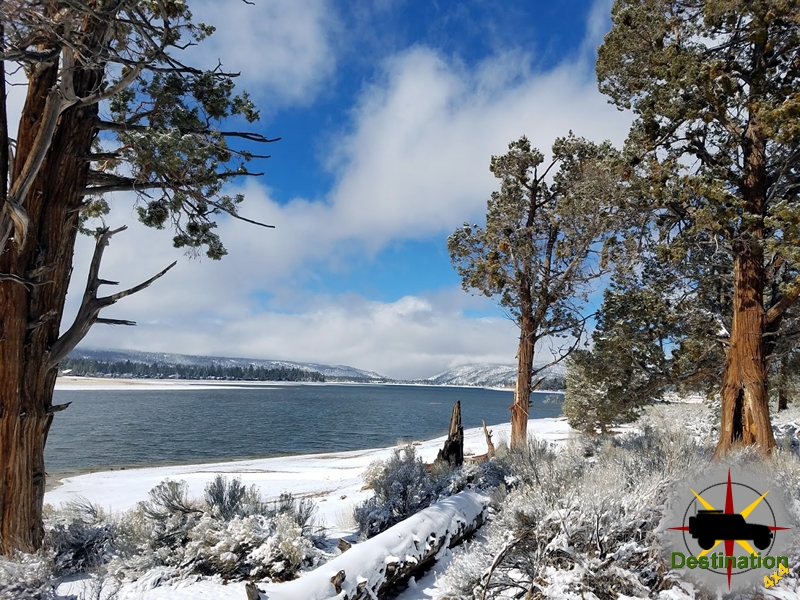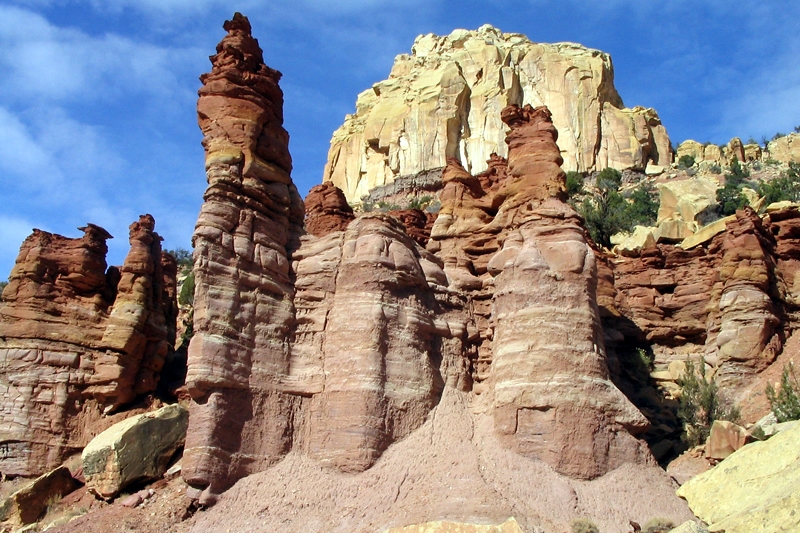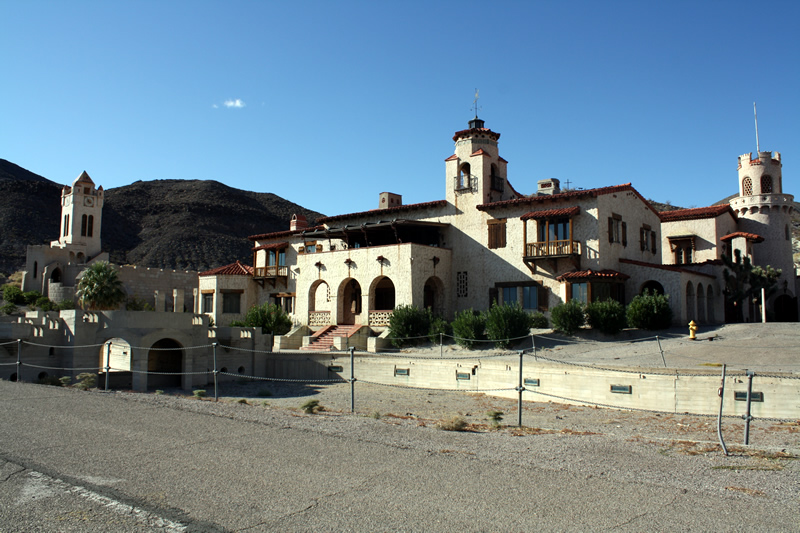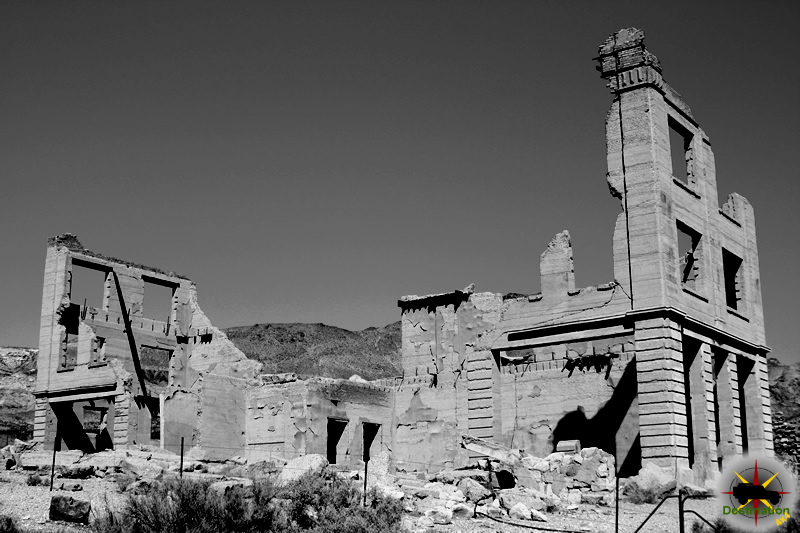
Leadfield California – A Death Valley Ghost Town
Leadfield California is a ghost town located in Inyo County and Death Valley National Park and found on the Titus Canyon Trail. The town boom in 1925 and 1926, however, Leadfield is a town that was started on fraud and deceit.

According to Legend and an article in Desert Magazine, and shameless promoter C. C. Julian wandered into Titus Canyon and started blasting tunnels. He then discovered lead ore which he purchased and brought down from Tonopah, Nevada. Julian then produced maps and other promotional materials and found investors from the East coast. The town of Leadfield was born and died on the imagination of this one man.
![Photograph of an exterior view of the Leadfield Hotel in Death Valley's Titus Canyon, [s.d.]. The hotel is a simple wooden structure with a slanted roof and a rectangular façade. The upper left corner of the façade is missing, revealing the interior of the building. Three large rectangular windows and two doors alternate across the front of the building. There are three people standing on a caved-in porch in front of the hotel. A large rocky mountain rises up behind the hotel. The hotel was part of C. C. Julian's Leadfield boomtown, the hey day of which was in 1925. Photo Credit “University of Southern California. Libraries” and “California Historical Society” as the source. Digitally reproduced by the USC Digital Library.](https://i0.wp.com/www.destination4x4.com/wp-content/uploads/2022/03/CHS-13040.jpg?resize=800%2C637&ssl=1)
The truth of the tale is not quite as interesting or spectacular. According the the National Park Service, Leadfield ore was first worked in 1905. During the Bullfrog boom, which took place outside of Beatty, prospectors worked the land looking for the next big hit. In the fall of 1905, nine mine sights were identified and claimed by W. H. Seaman and Curtis Durnford. The ore from these sites was assayed in Rhyolite at $40 per ton. The men bought out a local consortium and the Death Valley Consolidated Mining Company was incorporated which released promotional material and sold shares for 2.5 cents each.
The mine and its ore did produce, however the Death Valley Consolidated Mining Company soon discovered that the expense of hauling the ore to Rhyolite and then the frieght costs to ship the material to smelters further off caused the ore to be not profitable. After six months of operation the Death Valley Colisidated Mining Company disappeared.




Despite early failures, in March of 1924 three prospectors wandered into the canyon and staked several claims. Ben Chambers, L. Christensen and Frank Metts worked their claims of lead ore for over one year before selling the claims to John Salsberry. Mr. Salsberry saw enough promise to form the Western Lead Mines Company and started to raise capital via stock sales at $0.10 per share. By the end of 1925, the Western Lead Mines Company was working 50 claims in the valley and soon began in invest in infastructure in the form of a compressor plant. A long steep road was constructed for LeadField to the Beatty Highway.
In early 1926, the Western Lead Mines Company build a boarding house and piped in water from a nearby spring. The town of Leadfield was named officially January 30th, 1926. Stock from the Western Lead Mines Company went on sale in January and within a 24 hour period, 40,000 share of stock were sold at $1.57 per share.
In February 1926 it became known to the public that C. C. Julian purchase shares and was now President of Western Lead Mines Company. Almost immediately the California State Corporation Commission began an investigation into the stock sale because a permit was not granted for the stock sale. The promoter went to work, along with several other mine operations, raise interest and money for the town. City plans were filed with Inyo County, however the spectre of investigation loomed.
Despite the arrival of a post office, investment into the location, and hundreds of feet of tunnel, C. C. Julian was ordered to cease sale of stock by the California State Corporation Commission. Around the same time, the primary tunnel of the Western Lead Mines Company penetrated to the ledge which experts predicted the highest quality ore. This ore was assayed at 2% and far too low for profit considered freight costs.
Leadfield and the surrounding mines where gone months later. Mr. Julian was blamed despite the facts that he did not start the venture, there was ore at the location, and he invested money and time towards the venture. Once his Leadfield venture faltered, he moved onto to Oklahoma and was caught up in yet another scam. Julian later fled the country for Shanghai in March of 1933 m where he committed suicide in 1923 after several more failed schemes. Julian was buried in a beggers coffin and his funeral was attended by nine people.
Mr. Julian is responsible for the road through Titus Canyon, which many is a favorite route of visitors every year.

For a detailed history, the NPS offers a great article.
Leadfield Town Summary
| Name | Leadfield |
| Location | Inyo County, Death Valley, California |
| Latitude, Longitude | 36.8466107,-117.0592307 |
| GNIS | 1658952 |
| Elevation | 4000 feet |
| Newspaper | Leadfield Chronicle ( 192?-19?? ) |
| National Register of Historic Places | 75000221 |
Further Reading
- Ghostotwns.com
- Digital Desert
- NPS.gov
- https://homesteadmuseum.blog/2019/07/20/drilling-for-black-gold-the-strange-saga-of-c-c-julian-part-one/
Leadfield Map
Resources
St Thomas Nevada – Clark County Ghost Town
Founded in 1865 when Brigham Young sent settles to the confluence of the Virgin River and Muddy Rivers. St Thomas Nevada remained a Mormon settlement until 1871 when a surveying correction placed the town in Nevada. When the Mormons abandoned the area, other settlers claimed the property. St Thomas used to served as a pit stop for travelers between Los Angeles, California and Salt Lake City, Utah using along the old Arrow Highway (US 91).

The United States Federal Government “purchased” the land as part of the Hoover Dam project. In actuality, there were multiple suits as the residents of St. Thomas raise complaints about the amount the federal government was paying for their land. In time, the residence lost and the entire town was doomed to its destiny and the water of Lake Mead continued to rise.

The last known resident as Hugh Lord, who remained until the water surrounded his home. He loaded is possessions into a row boat, set fire to his home, and rowed off into history. Soon the rising water of Lake Mead swallowed the entire down, and wasted the landscape with water 60 feet deep. From time to time, the lake level will drop low enough to expose this lost town.
The town is currently exposed, and lies in the lake bed surrounded by a large expanse of tamarisk. The dirt road to the trail-head is located just inside the entrance to Lake Mead National Recreation Area when coming from Moapa and Overton and the trail is beyond simple and suitable for almost every vehicle.

The 2.5 miles hiking trail is very easy and takes you from the trail-head and loops through the town. The trail would be a bit more difficult if you attempt the trail during the hot summer months. Remains of the town are limited to foundations, some old wood fence posts and some metal artifacts such as farming equipment and a V-8 small block. The park service appears to cut the tamarisk back to expose the foundations for visitors, however the cut off tamarisk trucks can be a tripping hazard and would be harsh it you fell on one, so keep in eye on where you step.

I have been to many ghost towns over the years. Many of them lost in history due to mines failing to produce, fire, hard environments and disease. St Thomas is different from all the others. This is a ghost town by design, by protest and there is no better reminder than the fresh water clam shells which litter the site. The fact that there are viable towns (Moapa and Overton) just a few miles away make St Thomas all the more poignant.

St Thomas Trail Map
Upper Antelope Canyon
Located just outside of Page, Arizona Upper Antelope Canyon is arguably the best known slot canyon on the planet, yet few people will know its name outside of desert enthusiasts. For those unaware of these structures, slot canyons are extremely narrow canyons, carved by water, which are typically just a few feet wide, but may be just a few inches. The typically arid dessert can instantly turn into raging torrent of water in just a few minutes with just a few inches of water. This water picks up speed, and debris such as sand, which scours the landscape including rock. Antelope Canyon is found on Navajo Tribal land, and access to the canyon is only allowed with a Navajo Guide.


Antelope Canyon is actually two separate slot canyons located a short distance from each other on either side of US 98. Upper Antelope Canyon is know as Tse’ bighanilini, which in Navajo means “the place where water runs through rocks.” Travel to the Canyon is done via Navajo run transport and you are allowed about 2 hours for your visit. The site is at about 4,000 feet elevation and the canyon walls rise 120 feet above a stream bed.
I would like to thank the LeChee Chapter of the Navajo Nation for keeping this location sacred and available to us.
James Rathbun, Destination4x4.com
Access into the upper canyon is simply a walking into a canyon. The trail is flat and sandy and very easy to manage. Upon entrance into the Upper Antelope Canyon you are immediately struck by the texture and color of this place. Just inside the entrance, is a small chamber which seems to great you, and the pink and orange glow of the light bouncing off the walls force your eyes up. The geography is such, that the narrow opening high above you lets in a small fraction of the available light, and that light bounces down towards the bottom of the canyon.
Relatively short, Upper Antelope Canyon may be traversed in just 5 minutes. However, this is simply a waste of your time if you just rush through. The only complaint of the canyon, are the other visitors. As a photographer, I have many photographs ruined by people turning a corner and walking into my frame while I was making an exposure. This does not mean they were rude or anything but patient, but rather an unfortunate side effect of composing photographs with long exposure times in a 18 inch wide slot Canyon.

As with all beautiful things, we must share this location and Antelope Canyon is a must stop location every time I visit the area. There is a hidden danger, in that the very forces which sculpt a slot canyon are still very much in play and every few years a new story will appear about someone being killed in a slot canyon due to a sudden flash flood.
I would like to thank the LeChee Chapter of the Navajo Nation for keeping this location sacred and available to us.
Upper Antelope Canyon Map
Goblin Valley Utah

Goblin Valley is located in Utah is a state park and campground which is adjacent to eroded flood plain. Formed by water, time and a soft sandstone, erosion sculpted the limestone into unique rock formations which some have stated appears to be goblins. The Goblin Valley itself is a day use hiking area which allows one to get lost in the maze of spires and rock formations.

Each rock spire ranges in height from 3 feet to about 20 feet tall. The fragile structures litter the landscape and sadly on occasion have been felled by people who do not have respect for nature. There are three established self, however the Valley of the Goblins is a open trail flat mud plane after a easy and short trail down from the parking area.
Goblin Valley State Park does offer an established campground of 22 campsites just over a hill from the Valley of the Goblins. The campground features, paved sites, bathrooms, showers, water and dump stations. The campground is very popular destination due to location next to Goblin Valley and is also a wonderful centralized base camp location for exploring the San Rafael Swell.

We stated in Goblin Valley in the off season several years ago. We were greeted with lots of camp sites available, privacy and a minor wind and rain storm. Despite the less then desirable conditions, we enjoyed our stay and will try to make it back again in the future.
Continue Reading →Antelope Valley California Poppy Reserve

Established in 1976, the Antelope Valley California Poppy Reserve is located just west of Mojave and boasts the most consistent blooms that the California Poppy. The reserve does not plant or water the flowers, so the timing and abundance of the flowers is solely dependent upon rainfall each year. The bloom season begins late winter and may last throughout the spring depending upon conditions. In addition to the poppy, the Reserve also hosts a variety of species including Owl’s Clover, Davy Gilia, Goldfields, Lupine and Cream Cups.
The 1745 acre flower reserve ranges in elevation frim 2600 to 3000 feet in elevations and boasts 7 miles of trails. There are limited facilities, but the reserve does have some wheel chair access.

The California Poppy ( Eschscholzia californica ) is a small perennial is typically a short flowering planet which boasts a vibrant orange bloom. The flower itself grows on top of a sledder stalk and the four petal flower which has a silky texture, appears extremely delicate and vulnerable to the elements. The flowers open each morning and close in the evening with the cooler air.

The California Poppy has a large range which included more of California, parts of Oregon, Washington, Nevada, Arizona and Northern Baja California.






